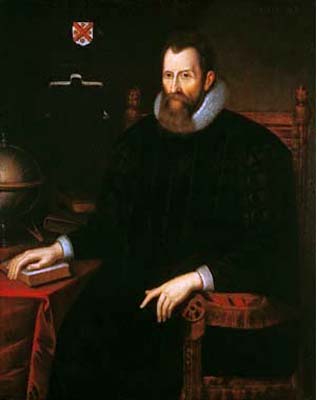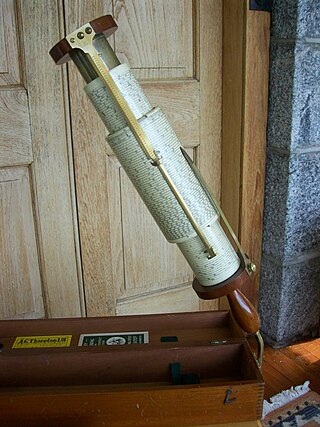
In mathematics, the logarithm is the inverse function to exponentiation. That means that the logarithm of a number x to the base b is the exponent to which b must be raised to produce x. For example, since 1000 = 103, the logarithm base of 1000 is 3, or log10 (1000) = 3. The logarithm of x to base b is denoted as logb (x), or without parentheses, logb x. When the base is clear from the context or is irrelevant, such as in big O notation, it is sometimes written log x.

A slide rule is a hand-operated mechanical calculator consisting of slidable rulers for evaluating mathematical operations such as multiplication, division, exponents, roots, logarithms, and trigonometry. It is one of the simplest analog computers.

A logarithmic scale is a method used to display numerical data that spans a broad range of values, especially when there are significant differences between the magnitudes of the numbers involved.
In number theory, Skewes's number is any of several large numbers used by the South African mathematician Stanley Skewes as upper bounds for the smallest natural number for which

In mathematics, the prime-counting function is the function counting the number of prime numbers less than or equal to some real number x. It is denoted by π(x) (unrelated to the number π).
In mathematics, specifically in calculus and complex analysis, the logarithmic derivative of a function f is defined by the formula

William Oughtred, also Owtred, Uhtred, etc., was an English mathematician and Anglican clergyman. After John Napier invented logarithms and Edmund Gunter created the logarithmic scales upon which slide rules are based, Oughtred was the first to use two such scales sliding by one another to perform direct multiplication and division. He is credited with inventing the slide rule in about 1622. He also introduced the "×" symbol for multiplication and the abbreviations "sin" and "cos" for the sine and cosine functions.
Sound power or acoustic power is the rate at which sound energy is emitted, reflected, transmitted or received, per unit time. It is defined as "through a surface, the product of the sound pressure, and the component of the particle velocity, at a point on the surface in the direction normal to the surface, integrated over that surface." The SI unit of sound power is the watt (W). It relates to the power of the sound force on a surface enclosing a sound source, in air.

Florian Cajori was a Swiss-American historian of mathematics.
Edmund Gunter, was an English clergyman, mathematician, geometer and astronomer of Welsh descent. He is best remembered for his mathematical contributions, which include the invention of the Gunter's chain, the Gunter's quadrant, and the Gunter's scale. In 1620, he invented the first successful analogue device which he developed to calculate logarithmic tangents.
In mathematics, the von Mangoldt function is an arithmetic function named after German mathematician Hans von Mangoldt. It is an example of an important arithmetic function that is neither multiplicative nor additive.
In mathematics, the explicit formulae for L-functions are relations between sums over the complex number zeroes of an L-function and sums over prime powers, introduced by Riemann (1859) for the Riemann zeta function. Such explicit formulae have been applied also to questions on bounding the discriminant of an algebraic number field, and the conductor of a number field.
The sector, also known as a sector rule, proportional compass, or military compass, was a major calculating instrument in use from the end of the sixteenth century until the nineteenth century. It is an instrument consisting of two rulers of equal length joined by a hinge. A number of scales are inscribed upon the instrument which facilitate various mathematical calculations. It was used for solving problems in proportion, multiplication and division, geometry, and trigonometry, and for computing various mathematical functions, such as square roots and cube roots. Its several scales permitted easy and direct solutions of problems in gunnery, surveying and navigation. The sector derives its name from the fourth proposition of the sixth book of Euclid, where it is demonstrated that similar triangles have their like sides proportional. Some sectors also incorporated a quadrant, and sometimes a clamp at the end of one leg which allowed the device to be used as a gunner's quadrant.
In measurement, the Coggeshall slide rule, also called a carpenter's slide rule, was a slide rule designed by Henry Coggeshall in 1677 to help in measuring the dimensions, surface area, and volume of timber. With his original design and later improvements, Coggeshall's slide rule brought the tool its first practical use outside of mathematical study. It would remain popular for the next few centuries.

The history of logarithms is the story of a correspondence between multiplication on the positive real numbers and addition on the real number line that was formalized in seventeenth century Europe and was widely used to simplify calculation until the advent of the digital computer. The Napierian logarithms were published first in 1614. E. W. Hobson called it "one of the very greatest scientific discoveries that the world has seen." Henry Briggs introduced common logarithms, which were easier to use. Tables of logarithms were published in many forms over four centuries. The idea of logarithms was also used to construct the slide rule, which became ubiquitous in science and engineering until the 1970s. A breakthrough generating the natural logarithm was the result of a search for an expression of area against a rectangular hyperbola, and required the assimilation of a new function into standard mathematics.

In mathematics, the Riemann hypothesis is the conjecture that the Riemann zeta function has its zeros only at the negative even integers and complex numbers with real part 1/2. Many consider it to be the most important unsolved problem in pure mathematics. It is of great interest in number theory because it implies results about the distribution of prime numbers. It was proposed by Bernhard Riemann, after whom it is named.

Elias Allen was an English maker of sundials and scientific instruments.

Mirifici Logarithmorum Canonis Descriptio and Mirifici Logarithmorum Canonis Constructio are two books in Latin by John Napier expounding the method of logarithms. While others had approached the idea of logarithms, notably Jost Bürgi, it was Napier who first published the concept, along with easily used precomputed tables, in his Mirifici Logarithmorum Canonis Descriptio.

The A. W. Faber Model 366 was an unusual model of slide rule, manufactured in Germany by the A. W. Faber Company around 1909, with scales that followed a system invented by Johannes Schumacher (1858-1930) that used discrete logarithms to calculate products of integers without approximation.

The Fuller calculator, sometimes called Fuller's cylindrical slide rule, is a cylindrical slide rule with a helical main scale taking 50 turns around the cylinder. This creates an instrument of considerable precision – it is equivalent to a traditional slide rule 25.40 metres long. It was invented in 1878 by George Fuller, professor of engineering at Queen's University Belfast, and despite its size and price it remained on the market for nearly a century because it outperformed nearly all other slide rules.
















